| |
| |
| -- 30th January to 8th February 2012-- |
| |
|
No doubt about it, we’re in the Antilles now! Splendid beaches, crowded anchorages, magnificent coral reefs, American tourists (hordes thereof), tropical forests, over-priced ship chandlers... It takes a couple of days to adjust when you’re coming from deep down the jungle – but one can really get used to turquoise waters :o)
More pictures and a film in bright blue on our pages Pictures and Film
|
|

77 miles until Grenada and 67 miles betzeen the islands
7657 miles since the start
|
|
|
|
| |
|
30th – 31st January: Tobago - Grenada (77 M)
|
|
|
We got our passports stamped out and our last TT dollars converted into papayas, bananas, mangoes, flour, rice etc (and two beer cans to add up to the total). We’re ready to go. Grenada calling. The wind is still blowing hard on the anchorage though... a last look at the forecast doesn’t show anything better for the next days: 20 knots all the time. We’ll have to get used to sailing against that kind of wind. We weigh the anchor at dusk, leaving the security of a good anchorage to sail into the night – expecting some sport. That’s the usual pang of apprehension again, as the anchor comes back on the deck and nothing holds us to anywhere anymore – we’re not safe, we have to keep an eye and an ear out at all times, only when the anchor will be holding good on the ground again shall we relax entirely (note: I say “holding GOOD on the ground” – we’re never as casual dropping the anchor as before the episode “Dragging and drifting 5 times in a row – welcome to Paramaribo” :-S ).
|
|
|
They say the wind against, then to the beam. We take a cautious two reefs and hoist the gib – from now on this smaller front sail is our new best friend, instead of our good genoa used on even better long tacks down winds... (sigh, miss the trade winds already). We’re soon out of the shelter from Tobago and the wind is more stable, the swell increases. We stay there, sitting in the cockpit in the dark, silently watching as the very last of the daylight make place to a bright moon. Doesn’t look so bad actually – we won’t even need the third reef! We get a quick noodle diner and start on the watch-rounds routine (keeping the rounds shorter so as to sleep both twice before dawn). Nothing important during the night: only a few maneuvers and a methane-carrier sailing full speed towards us with the radar off (luckily they had the radio on!). As the sun rises we see Grenada becoming bigger and bigger. Green hills, looks nice... but, what are those white vertical stripes in every corner of the shore? Masts? Masts by the dozen indeed – we’re forgetting about our plan to enjoy the QUIET little anchorage in Hog Island on the spot. We are sailing into Prickly Bay by now: a wide sheltered bay, never seen so many boats anchored together before! It’s like looking for a parking space on a huge shopping mall parking lot. We’re looking for the other small-and-cuties... hey, there’s Ratafia over there! We’ll be good next to our friends :o)
|
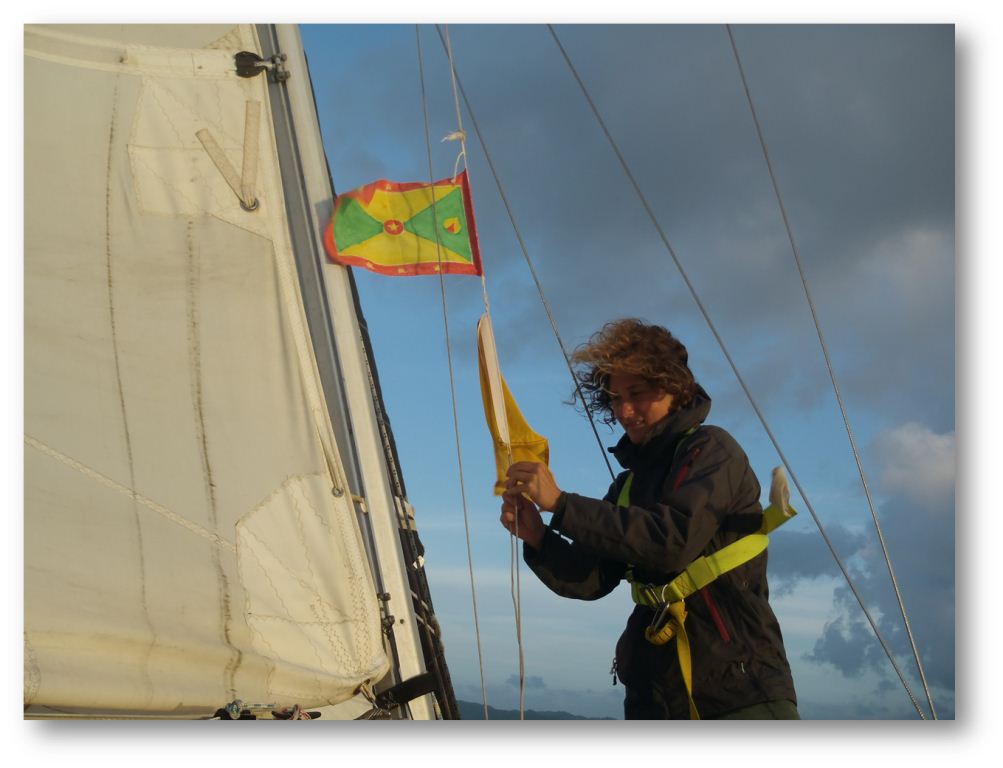
We're getting closer, it's high time to hoist the national flag !
|
|

Prickly Bay seen from a nice villa with a neat garden
|
The bay is divided into two areas: east by the small marina there’s a dinghy dock and the customs office; deeper into the bay to the North, another dock by the chandlery and the shipyard. The latter is easier to get a bus to town. Both locations have everything (water, internet, laundry...). Caution: shallow waters are not marked between the two areas by the cliff.
|
|
| |
|
31st January to 4th February: Grenada (16 M)
|
|
|
The anchor touched the ground at 8 am on a Tuesday morning: there’s nothing any customs officer could say against that! Of course we pay them a visit asap. While Camille is filling more forms (health declaration: no there’s nobody sick onboard – seasickness doesn’t count!), Laure runs to the nearest bank and gets some local dollars. East Caribbean dollars, EC$, are used in the majority of the English speaking Antilles. Easy. Laure comes back with the cash – but no card... card retained by the mean machine, the careless cashier said to come back tomorrow... well at least we can pay the customs (66 $EC total, around 20 euros). Those officers are ranking first on our rudeness scale – and we’ve seen a good deal of officers by now! Right after Customs on our priority list comes the ship-chandler: Budget Marine, next to the yard. First chandlery since Tenerife in October! We might keep up not breaking anything, we’re ending up with a looooong list of things to buy. Such a pleasure to smell the typical odor of new ropes and paint, to see the cupboards full of spare pieces of all shapes and sizes... full of everything, except what we’re looking for :o( (that’s to say a led navigation light, if you remember well from the previous episodes). Damn! We go and walk our disappointment off amongst the bougainvillea-rich gardens of the beautiful houses along the bay and to the points. The landscape is different again here, a new world after only a night’s navigation. Not so humid, lower plants – and completely tamed and trimmed into clean gardens for Americans in holidays.
|

There's one cow amongst the villas !
|
|

The church "tyically British" has been destroyed by the hurricane Ivan in 2004
|
On the next morning the card is redeemed – relief. We hit the town: Saint Georges. The bus to the capital city reminds us of the “alugers” in Cabo Verde: there’s one driver (driving fast in a packed minivan) and one assistant (hurrying the clients into the van, piling them up and getting their money – as well as turning on the music, always too loud). There are many and frequent bus lines throughout the island (mostly converging to Saint Georges), it’s easy and cheap to get from A to B (the names are displayed on the windshield). The town is climbing up the hills from three main boroughs: the cruising harbor to the South, the Carenage harbor (historical center) and the commercial quarter on the other side of the hill, where the cruise ships are moored. Walking along the Carenage one could almost feel in Guernsey – only, every color saturated in the bright sun. There stand old warehouses made of bricks that served as ballast to the old colonial trade ships.
|
|
|
We like this town with its British twist under the sun. We walk to the fort on the hill and to the Anglican church standing by. Or at least the remains of it: only the bell tower and two walls survived the hurricane Ivan that destroyed the island in 2004. Ivan flattened out 70% of the buildings, wrecked 90% of the ships and annihilated 90% of the nutmeg plantations. Before that time, the small island of Grenada used to be the second producer worldwide of that specific spice, after Indonesia. There’s a nutmeg on the national flag – so important is it. Luckily they grow other food as well: on the market we find the same lunch boxes as in Tobago: fish or meat, and a mix of various pasta, rice, salad, pie, fried bananas etc. We enjoy this cheap and good lunch sitting by the pier and watching two huge cruise ships continuously vomiting a flow of white elderly American tourists. Most tourists in Grenada come by cruise ship it seems.
|
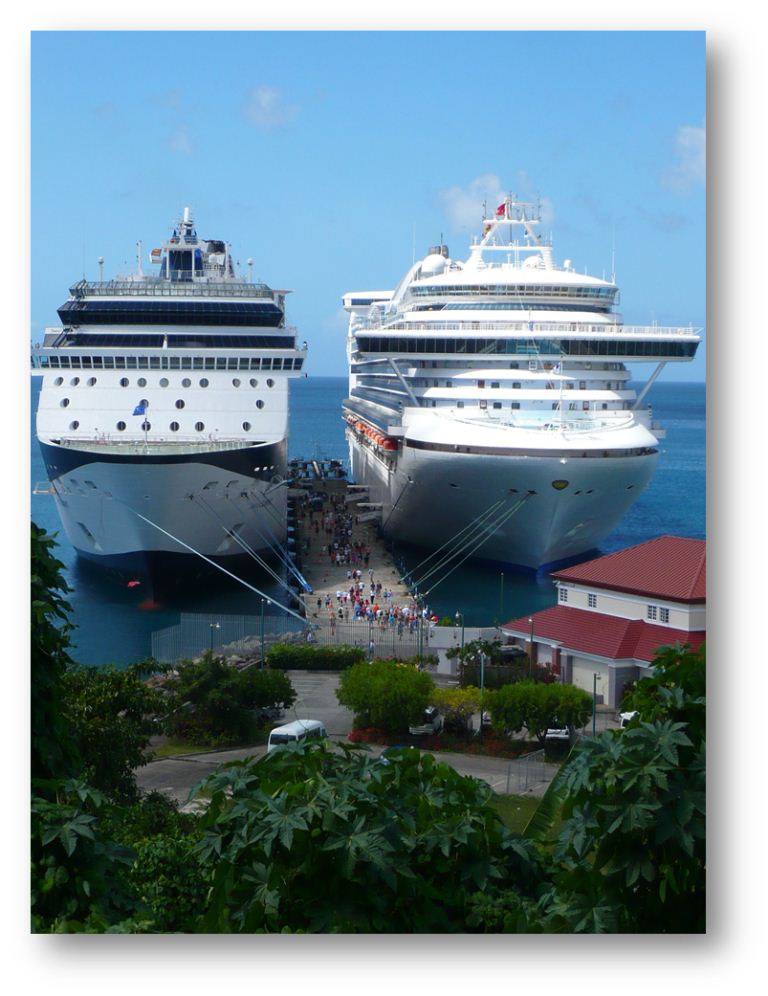
It's not for claustrophobics...
|
|
In the Lagoon, on the Southern side, there’s a new marina using up most of the space. No space left to anchor. But another ship-chandler: and they have IT, the ultimate object of our quest, the magical light! (The price brings us back to earth... and they’re duty free, just like in the other chandlery! If you don’t have the customs clearance with you, you pay another 51% tax!)
We got to the bottom of our todo list for the week, we may go out and explore now. Another bus takes us to the Grand Etang National Park (pronounce “granita”... just like Tobago the island changed hands countless times between the French and the English until the end of the 18th century, resulting in an interesting mix of location names). National Park = hiking trails in the forest – we thought... In front of the information board a class is standing, kids of 10 seriously listening to their teacher who is gesturing and showing around the natural beauties of the place – we assumed. Curious of her explanations, we get closer: “Look around, what do you see?” (Well, trees, mountains, high ferns...Many even an exotic bird of two). She pauses. “There’s a road, that’s an access. Then there’s a parking place, for the buses and the cars, that’s right... and what else?” (Uhmm... forest rangers in a small house?). “There are souvenirs shops indeed, and people dressed in folkloric costumes playing music... people come here to see nature, that’s called ECOTOURISM – please take careful notes, you’ll need it for next week’s test.” Right. They’re 10 and learning about ecotourism. Grenada’s strategy for the future could not be clearer.
|
|
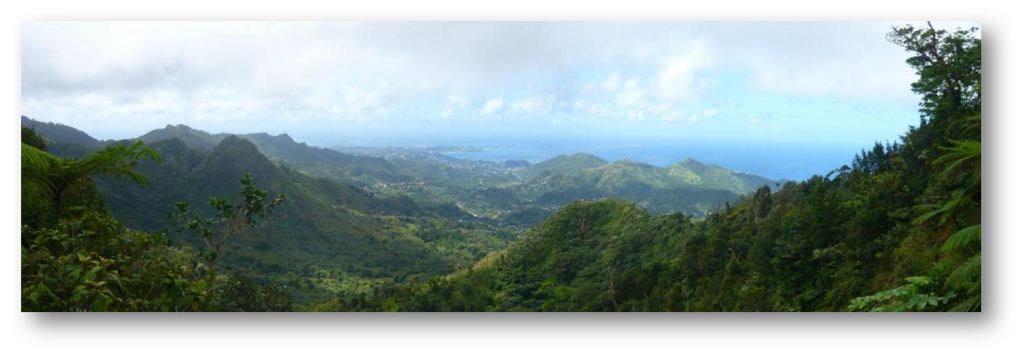
Grenada to the South West
|
|

Last thing we saw before the rain
|
Alright, we’re here for the “ECO” part of the word, and want to do some walking. The guide starts the conversation by “see, you’re here, and your cruise ship is there” (showing the cruise ship dock in St Georges). Meeeeeeep wrong, girl! “So here you can walk around the lake, easy and flat, and even feed our fresh water fish...” Meeeep, wrong again! We want to hike, where are the paths? There’s no map left of the park, and we learn that most of the trails are closed and not maintained. And that’s what we paid the entrance fee for? Anyways, after checking with another guy a bit more into hiking we set off to climb on the Mount QuaQua (750m) and then downhill to the Concord Falls. Of course as we’re approaching the top the clouds gather and stick to the summit – having a great open view from one summit once in that trip wouldn’t be normal. We enjoy the walk nevertheless, through bushes and palm trees and ferns, nothing higher than 2m.
|
|
|
Going down the path is very slippery and muddy (great a mud-bath for free!). It runs along a small spring, growing into a clear river jumping between beautiful round rocks as we progress. Lower than 300m there are more trees and tropical vegetation again, and bamboo bushes by the water. Closer to the coast finally there are cultivated fields of bananas, papayas, corn, cane... and cacao trees! Fruits are still growing on some abandoned fields: we find two nice groups of bananas – to go with the papayas we picked yesterday – just love getting our food directly from the plant! The river has turned into a small cascade by now, time to wash off the mud! We have one foot in the water already when we see Sandrine and Fred from Ratafia passing by! (Good that we put on our swimming suits in the end...). Surprise! The conversation is cut short by a sudden shower: they run for shelter, and we hide in the water in order not to get wet. At the end of the trail we’ll find time for a chat around a cold beer, waiting for the bus.
|

Our swimmingpool and its jacuzzi
|
|

A small house in Grenville
|
Grenada is a big island: it takes a good hour to cross it from West to East on the next day and get to Grenville. This little town on the wind coast is quite isolated. No boat, no tourist: perfect goal for a day trip – by bus! We find there bigger streets busier than expected, bustling with plain commercial activity, lots of regular shops – nothing picturesque or traditional, just regular streets with normal people running in and out of plain buildings. However protected from the swell by a coral reef, the beach is swept by the wind. According to our map there must be a nutmeg plant somewhere outside the town and we start looking for it. People wave to us on the street, as they always do since Tobago. A friendly word mostly, they rarely insist (except when they have something to sell). As we are bending over our map, a short quick woman in her 40’s comes by. We wears nothing by an old ragged shirt, her right eye has been blinded by some illness. She speaks only creole and no English, but says to follow her to the nutmeg place. She walks quickly and leads us out of the street onto the beach. Not quite sure what she really wants from us, we follow her keeping a good distance. She becomes aware of our fear actually and says something, showing her rags. Then we’re back in the city, on the crowded streets, following her in disbelief as our map indicated the opposite direction. Finally we get to a big building, we just have the time to read the “Welcome to the Nutmeg plant” sign that our guide is already talking to the gatekeeper and insisting that she takes care of us. Then she runs away, smiling and waving goodbye, while we’re sheepishly trying to collect our thoughts and find a way to make up for our coldness. Ashamed. We did not even ask her name.
|
|
|
The factory is one of the 18 collection points and 3 processing plants of the nutmeg producers’ corporation. Since 1943 (that’s well before the independence), farmers are co-owners of the processing and exporting company. That way they receive not only a daily income by the pound they deliver, but also a small share of the benefits at the end of the year. For a token fee a guide leads us on a private tour of the facilities: on the three levels of this huge building nutmegs are collecting, dried for a couple of months, scaled, washed and dried and sorted out again, before being put in a bag on a truck for export. All the tools are in wood, all the work is manual. The place smells of wood and varnish and nutmeg of course. More impressively, it’s almost empty, ghostly quiet: the production has not recovered from Ivan’s damages and is still stagnating at about 10% of the capacity. It is a very interesting tour and we leave the place happy with a bag of nutmegs in one hand and the tongue numb after biting in a piece of “mace” (the red scale around the nuts, used as spice and preservative).
|
|
|
Between two buses we go shopping in Saint Georges: even in the capital city of this big island fruits and vegetables are limited, and the so –called “supermarkets” are just bigger grocery stores. It’s been the same since the Canarias actually (excepted in French Guiana): there is little choice, finding butter or cheese is not taken for granted – not to mention ham. It’s a matter of culture: locals don’t buy stocks for weeks, they buy for the day, or for the next day, fresh products – they eat often on the street instead of cooking as well.
|

The 38th anniversary of the independance is coming up soon, the whole country is getting ready for it!
|
|

Yes, absolutely, this picture has been taken under the water - and yes, it is transparent water!
|
Back to the anchorage we have a nice drink on “Blue Wind" , the boat (made in Taiwan) of our Swiss/Californian neighbors. First boat we meet with only two women onboard as well :o) It’s hard to get up when the alarm goes on the following morning at 4.30. The plan was to make the most of the daylight and sail to Carriacou, the next island to the North – right against the wind. But the wind is still blowing in strong gusts and we have to go back to bed (too bad ;o) ). We’ll leave the anchorage some hours later under a bright sunshine, only to round the point, pass by Saint Georges and go to the next anchorage on the leeside of the island. Initially aiming for Halifax, we give up when we see the gusts sweeping the bay to the beach. By chance we end up taking one of the three buoys in Flamingo Bay (anchorage is not allowed – and nobody came to ask anything about the buoy :o) ). That’s a lucky call: this nature reserve has amazingly clear water and some astounding underwater landscapes! Corals of all shapes, bright fishes, and today’s special: big soft-looking cylinders – sponges!
|
|
| |
| |
| TOP
|
| |
| |
|
5th February: Grenada - Carriacou (47 M)
|
|
|
In the early morning a small group of white egrets come fly about the boat, standing on the solar panel and the oar, not at all scared of us! But we’re about to leave and they find less agitation on the next boat. The wind calmed down a trifle in the night. Or at least we feel less wind, on the leeside of this 800m high island. We cautiously set two reefs in the main sail to start with. Sailing North sheltered by the island is a pain: treacherous calms alternate with sudden and variable gusts – only the swell doesn’t stop! We breathe in relief as we pass the Northern point and can settle on a longer tack, nicely heeling in 20kts. Our mac’ & cheese lunch (straight out of the box, made in the USA) is interrupted by a loud “bang”: the gib falls on the deck, the halyard point broke. Camille runs to the front clean up the mess before unfurling the genoa. Of course we have to keep it rolled in that wind and the angle to the wind is far less good... and we start tacking and tacking again, not helped by the strong current pushing to the West between the islands. It takes us three endless hours to get closer to Tyrell Bay. Beautiful green hills are on each side of the bay and we contemplate the bright colors in the sunset. Many boats here as well, but less than in Prickly Bay. We sail as close to the shore as we can and drop the anchor in 3.5m water, aiming for the bright patch on the ground. Laure jumps in the water: the ground is of sea-grass but our anchor seems to hold well on it. OK! Last effort of the day to climb up the mast and get the halyard back before dark – and we can lay down and sleep, exhausted by one single day of sailing!
|
|

Carriacou seen from the West
|
|
| |
|
6th February: Tyrell Bay, Carriacou
|
|
It’s actually a piece of luck that our gib broke today: in Tyrell Bay is located a little sail-maker shop (In Stitches), which happened to be the last before Bequia... we bring a broken gib there and get it back a couple of hours later with a shiny new halyard point – for a reasonable price. Bliss! We will be able to tack close to the wind again :oD
In addition the place could be worse – clear bright blue water, white sand beach planted with almond trees (yummy!) and manchineel trees (poison!). Colorful houses stand on the beachfront, where we find a laundry and internet. Back onboard we enjoy a quieter day: despite the number of boats the bay is calm during the day and we climb up the mast to take pictures of the clear water – before jumping in it and exploring the local grounds. No coral here, only sea-grass with a few fishes and numerous ursine.
|
|
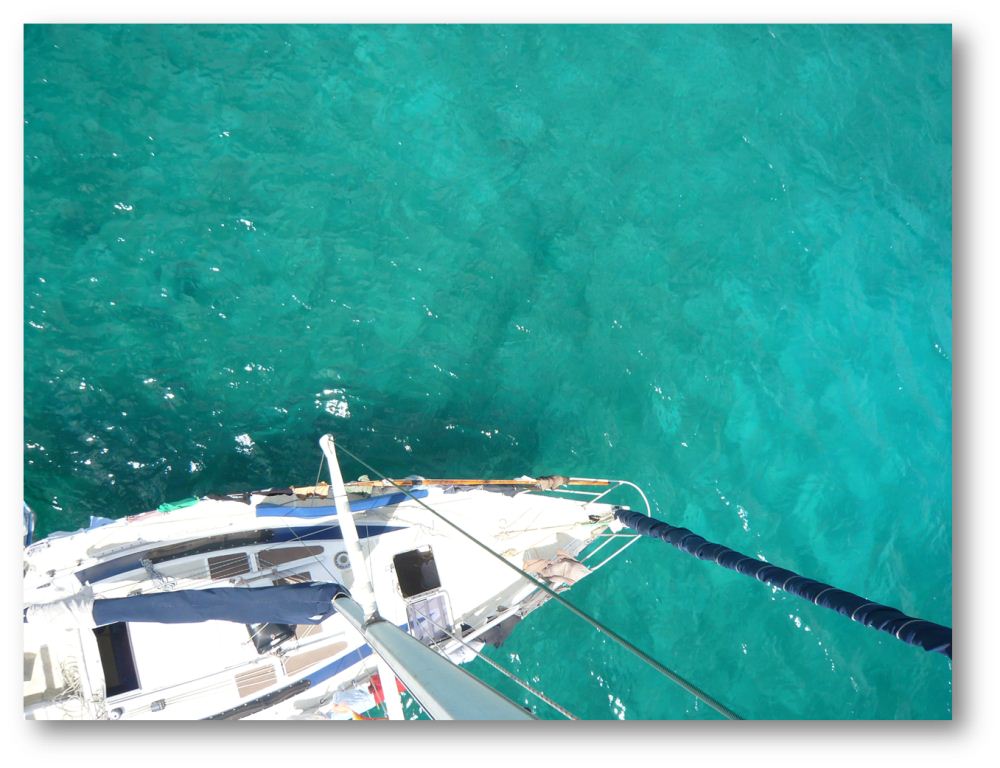
Saltimbanque floating on turquoise water
|

Tyrell Bay in Carriacou
|
|
| |
|
7th -8th February: Sandy Island and Hillsborough, Carriacou (4M, all with the engine on!)
|
|
|
Keeping up the good habits: alarm goes off at 6 am, we’re on our way soon after dawn towards a desert paradisiac islet called Sandy Island, on the Western side of Carriacou. Anchorage is forbidden in this natural reserve and we want to be sure and get a buoy. 3 miles motor-sailing. That’s not very elegant, but certainly efficient against the wind and between rocks. Only 3 boats are there when we arrive, and 15 more buoys guarantee space for many more.
|

Saltimbanque in front of Sandy Island
|
|
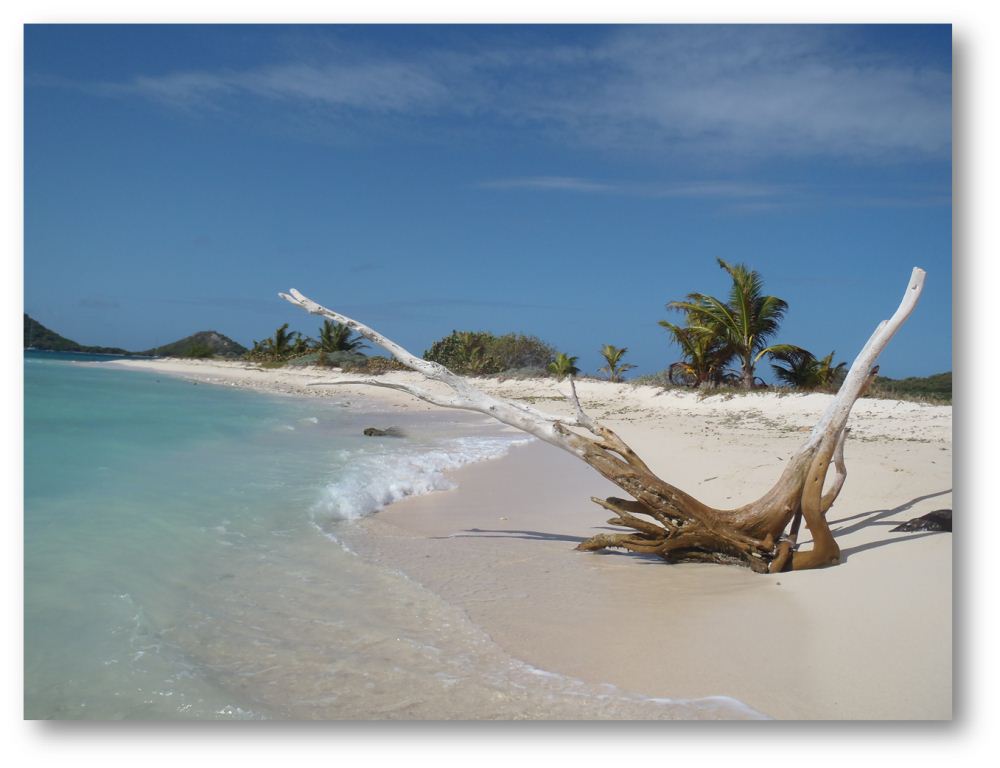
A quick thought for all those who stay stuck in traffic jams on the highway every morning...
|
Time for a second coffee watching the birds fishing in the turquoise water, and splash, we come to meet them! We get t shore swimming. Nobody on the island yet, except for a friendly Dutch family. Their boat is the former “Credit Agricole”, the racing yacht on which Philippe Jantot won race around the world in 1983. They turned it into a cruising boat – impressive to see from inside!
|
|
|
Sandy Island in itself is very small, made of white sand turning pink with chunks of coral. On one side the water shallow and turquoise, on the other dark and deep. Small green trees grow in spite of the strong wind. Sheltered by a dyke of dead coral a couple of transparent water pools seem to be made for kids (of all ages ;-) ) to play in. Lots of nice shells as well, and the face bones of a turtle! (Natural Reserve means we are allowed to bring only pictures back to the boat).
|

The face bones of a turtle (or at least we think it is) !
|
|

It's just the right temperature!
|
The underwater world yet is disappointing: some coral, some fishes, but the water is hazy and they are not so big. Are we becoming spoiled with the great snorkeling of the past weeks? Birds on the other hand are fantastic: many pelicans and a kind of gannet crying like a duck. We see many jack fishes jumping out of the water to surprise and eat smaller fishes – those smaller fishes jumping then in turn to escape... Nature has always some great show to offer us, everyday something new, we can’t get tired of it!
|
|

Sandy island...
|
|
But it’s time to leave this little paradise and sail on. We go to anchor to Hillsborough one mille further for the night.
4m deep, flat sand with a few sea-grass patches. We know our routine well by now: Camille steers with a close look on the echo sounder while Laure gets the 30m chain and anchor ready. We pick the place, we stop the boat, drop the anchor and as much chain as necessary to touch the ground. Then Laure lets the chain go slowly as the boat drifts in the wind (or current, or helped by the engine on reverse gear), so as to spread the 30m. Camille turns everything off and Laure jumps in the water to have a look at the anchor (really, that’s too bad I HAVE TO jump in this blue warm water all the time!). Less than 10 minutes later we’re ready for a drink!
|
|

Sunset in Hillsborough, from left to right Saltimbanque, Camille and Laure.
|
|
|
Hillsborough is a quiet town, not very touristic. Little choice in the groceries allas. Water and internet and everything available at the dock. Most importantly: customs and immigration – 3 forms and two stamps later and we’re out of the country, ready to set sails to the next islands, “Saint Vincent and the Grenadines” - that’s a good 5 miles from here!
|
|
| |
| TOP
|
| |
| |
|
|
|
|
|
